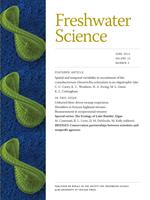According to stoichiometric principles, the ratios at which consumers recycle nutrients depend on the elemental compositions of the consumer and its food. However, nutrient assimilation efficiencies and ingestion rates can vary among consumer species and, thus, can affect the rates of consumer-mediated nutrient recycling (CNR). The grazer Theodoxus fluviatilis has high nutrient excretion rates of either P or N, depending on grazer growth limitation, and has a high body N. I examined how a grazer with a high proportion of N in its body tissues can assimilate enough N to maintain that N content despite high N excretion rates by estimating the mass balance for nutrient recycling including nutrient excretion through fecal pellets. I used the snail species Theodoxus fluviatilis and Lymnea peregra fed nutrient-enriched periphyton in a 2-d grazing experiment done in 48 experimental units. I estimated periphyton and grazer nutrient stoichiometry and nutrient excretion rates and ratios in dissolved and fecal-pellet form, and calculated nutrient assimilation efficiencies of the limiting nutrient (N). Theodoxus fluviatilis had higher N excretion rates, lower N assimilation efficiency, and higher ingestion rates than L. peregra. Thus, T. fluviatilis recycled more N by ingesting and processing a larger amount of food per unit time than L. peregra. My study shows that grazers with low nutrient assimilation efficiencies and high nutrient demands can assimilate sufficient nutrients via high ingestion rates. The consequence of this strategy (high ingestion and excretion rates) could be a more rapid nutrient turnover in ecosystems dominated by these grazers.
How to translate text using browser tools
1 June 2014
Compensatory feeding and low nutrient assimilation efficiencies lead to high nutrient turnover in nitrogen-limited snails
Antonia Liess
ACCESS THE FULL ARTICLE
It is not available for individual sale.
This article is only available to subscribers.
It is not available for individual sale.
It is not available for individual sale.

Freshwater Science
Vol. 33 • No. 2
June 2014
Vol. 33 • No. 2
June 2014
benthos
compensatory feeding
ecological stoichiometry
excretion
fecal pellets
grazer
periphyton




